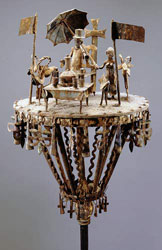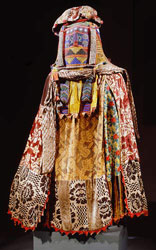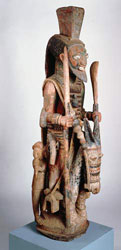


 the most elaborate court art in Africa comes from the country of Benin (once called Dahomey), home of the Fon kingdom, and from western Nigeria, home of the Yoruba and Edo kingdoms. Benin City, in Nigeria, is the capital of the Edo-speaking people.
the most elaborate court art in Africa comes from the country of Benin (once called Dahomey), home of the Fon kingdom, and from western Nigeria, home of the Yoruba and Edo kingdoms. Benin City, in Nigeria, is the capital of the Edo-speaking people.The Fon kingdom was established in the early 17th century. Artists working for the royal court created iron sculptures and staffs that were placed in the memorial temples of palace officials. Much Fon art incorporates animal imagery, symbolically associated with royalty and with proverbs that reinforce moral laws and the power of rulers.
 Since the seventeenth century, Yoruba-speaking peoples have been organized in a series of kingdoms. Carvings by well-known artists grace royal courtyards as architectural elements. Doors and verandah posts, like the bowls and trays used in ifa divination ceremonies, depict the exploits of particular rulers as well as the activities of ordinary people. Much Yoruba art is made in association with deities known as orisha, each associated with particular iconography. Eshu, the trickster; Shango, the god of thunder; and Ogun, the god of iron are among the best known orisha. Masks and headdresses are made to honor ancestors, ward off evil, and honor important members of the community.
Since the seventeenth century, Yoruba-speaking peoples have been organized in a series of kingdoms. Carvings by well-known artists grace royal courtyards as architectural elements. Doors and verandah posts, like the bowls and trays used in ifa divination ceremonies, depict the exploits of particular rulers as well as the activities of ordinary people. Much Yoruba art is made in association with deities known as orisha, each associated with particular iconography. Eshu, the trickster; Shango, the god of thunder; and Ogun, the god of iron are among the best known orisha. Masks and headdresses are made to honor ancestors, ward off evil, and honor important members of the community.The kingdom of Benin in Nigeria is the source of some of the best known works of art from Africa. For more than five hundred years, metal workers have been making objects that enhance the prestige of the king, or oba. Brass plaques decorate palace walls, and terra-cotta, wood, and brass heads representing male and female royal ancestors are placed on memorial shrines.



